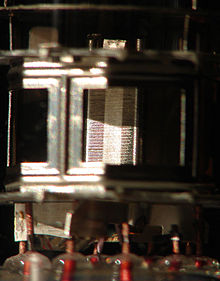Tension grid tube
A tension grid tube is an electron tube in which the wires that form the control grid do not have the shape of a helix, as is conventionally the case, but are stretched tightly at a short distance above the cathode.
The grid wire is particularly thin (approx. 7.5 µm) and is accordingly wrapped tightly and tightly around the grid frame ("tensioned"). The lattice frame consists of two lattice bars made of molybdenum as a carrier, around which the wires, also made of (gold-plated) molybdenum, are wound, and four bars that connect the bars with one another. The spars have a slightly larger diameter than the thickness of the - mostly rectangular - cathode. The fine lattice windings are fixed with glass solder , as the low processing temperature does not significantly affect the frame mechanically.
The invention of the tension grid technology was a major leap in development in tube technology. As with many technical developments, the idea of the tension grid arose in the Second World War from the need to shift the upper limit frequency of high-frequency tubes further to shorter wavelengths. But it was not until 1952 that Siemens began series production of the first European tension grid tube C3g , which was mainly used in long- distance telephony , where, due to the high signal losses , both high amplification and a high signal-to- noise ratio are required.
Tension grids can be made finer, since the wires do not have to support themselves as with the notch grids, they can have a smaller pitch as well as a significantly smaller diameter. The distance between the cathode tube and the grid wires is only about 0.04 mm. The result is:
- much higher steepness
- lower input capacitance, lower space charge zone, thus higher cutoff frequencies
- hardly any microphones (stiff frame, resonance frequency of the grid wires> 20 kHz, i.e. beyond the upper hearing limit )
- low noise figure
The open system structure enables a direct view of the wrapped tension grids. You can see the comparatively thick bars (spars) and also the lower bar that holds the grid under mechanical tension. The typical features in the two anode plates, which are used for dimensional accuracy, as well as the shielding between the two triode systems in the double triode are also clearly visible.
The best-known small signal tubes with tension grid technology are the triodes ECC803S, the ECC88, EC86 / E86C, EC88 / E88C and their P equivalents, as well as the HF pentodes EF184 / EF183. There were, however, numerous other tension grid tubes.
In the power tube sector, the EL503 end pentode deserves a mention. It was the last European development of an LF power pentode in tension grid technology and was brought onto the market by Philips in 1965/66 . Ultimately, however, it could no longer prevail over the transistor technology that had already been developed. Even the attempt at a new edition failed. The PL802 was the last and most advanced broadband pentode for video signal amplifiers in color television receivers.
The tension grid tubes of the type ECC88 and ECC803S can be recognized by a characteristic depression in the anode plate in order to achieve a small distance between the active area of the anode and the rest of the system. If the anode sheet used does not have this special feature or if it has embossed transverse ribs, it is usually a regular notch lattice tube .
Also known are the tension grid tubes from American (e.g. 6DJ8, 6922) and Russian production as well as the above-mentioned 6N23P or the 6S45P, which are widespread in audiophile circles .
literature
- Werner Espe: Materials science of high vacuum technology . 1: Metals and metallically conductive materials. VEB Deutscher Verlag der Wissenschaften, Berlin 1957.
- Werner Espe: Materials science of high vacuum technology . 2: Silicate materials. VEB Deutscher Verlag der Wissenschaften, Berlin 1960.
credentials
- ↑ Gold increases the work function in connection with the barium evaporated from the cathode.
- ↑ http://www.elektronikinfo.de/strom/spanngitter.htm
- ↑ http://www.jogis-roehrenbude.de/Roehren-Geschichtliches/EL503/EL503.htm

